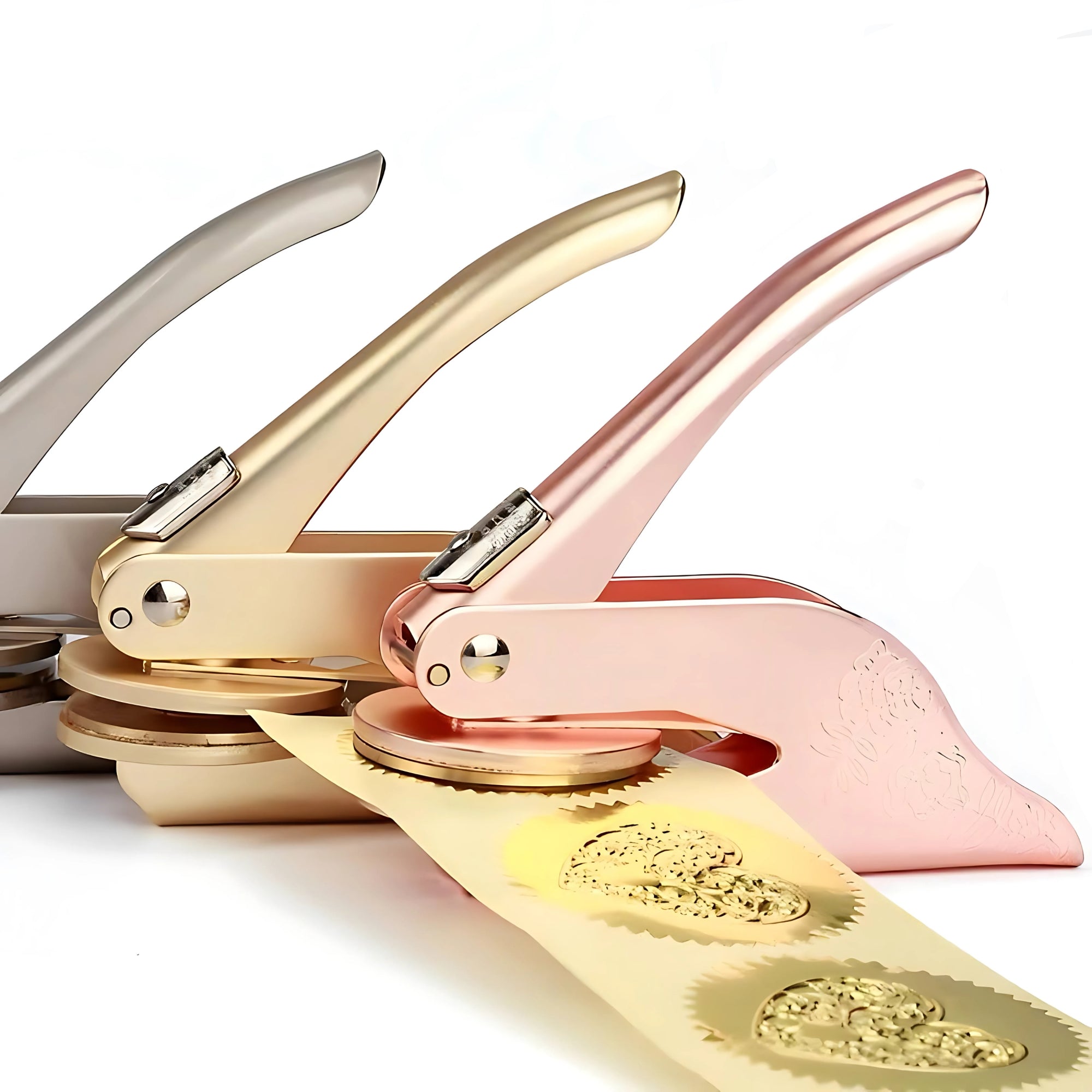손끝으로 금빛 대학 엠블럼을 쓸어내리면, 종이 위에 섬세하게 솟아오른 질감이 품격 있는 형태를 그려내는 것을 느낄 수 있습니다. 이 기법은 "엠보싱"는 정밀하게 설계된 금속 다이를 사용하여 종이를 눌러 뚜렷한 촉감의 융기 패턴을 만들어 일반 종이에 뛰어난 품질과 위엄을 부여합니다.
고대 마크: 엠보싱의 기원
엠보싱의 기원 고대 이집트 시대로 거슬러 올라가는 이 시대에는 숙련된 장인들이 금속, 가죽, 직물에 문양과 상징을 새겨 넣는 기술을 이미 터득하고 있었습니다. 당시 사람들은 다양한 소재로 고급스러운 효과를 내는 방법에 대해 상당히 높은 수준의 이해를 갖추고 있었습니다.
신성한 질감: 중세 시대의 엠보싱
중세 시대에는 엠보싱이 상당한 인기를 얻었습니다. 수도원은 서적 제작의 중심지로 부상했고, 수도사들은 손으로 쓴 원고의 가죽 표지를 장식하기 위해 엠보싱 기법을 자주 사용했습니다.
고귀한 장식: 르네상스의 엠보싱

기계적 진보: 산업 혁명의 엠보싱
그만큼산업 혁명은 엠보싱에 큰 활력을 불어넣었습니다. 새로운 생산 기술의 등장으로 황동과 강철로 만든 엠보싱 틀이 발전했고, 더욱 발전된 기계는 복잡한 무늬를 더욱 선명하고 세밀하게 만들었습니다.
빅토리아 시대에 이르러서, 양각 카드인사와 초대장은 유럽 전역으로 퍼져나가며 중산층이 우아함을 받아들이는 세련된 방법이 되었습니다.

동시에, 눈썰미가 뛰어난 브랜드들은 엠보싱의 독특한 매력을 활용하여 제품 포장에 접목시켰습니다.
코카콜라의 한정판 엠보싱 병을 살펴보세요. 세련되고 융기된 질감은 느낌을 향상시켰을 뿐만 아니라 소비자들 사이에서 폭넓은 화제를 불러일으켰으며, 오래된 기술을 현대적인 마케팅 전략으로 재치 있게 전환했습니다.
현대 디자인: 엠보싱의 부활
21세기에 이르러 엠보싱은 다시 주목을 받고 있으며, 이 고대 예술 형태는 현대 생활에서 새롭고 다양한 역할을 맡고 있습니다.
브랜딩에서 엠보싱은 포장의 질감과 인지도를 높여줍니다. 르네상스 기사들이 정교한 엠보싱 갑옷으로 귀족의 품격을 표현했듯이, 오늘날의 제품들은 장인 정신을 바탕으로 프리미엄 이미지를 구축합니다.
2021년 독일 iF 디자인 어워드 수상작인 라벨 없는 생수병은 엠보싱 기법을 친환경성과 심미성 측면에서 새로운 차원으로 끌어올렸습니다. 디자이너는 병에 투명하고 돌출된 패턴을 독창적으로 사용하여 기존 라벨을 대체하고, 바코드 정보를 인쇄했습니다.세련되고 깨끗한 느낌을 위해 캡에 직접 부착하세요.
당신이 발견하는 데 관심이 있다면 더 많은 실용적인 팁 엠보싱으로 포장을 한 단계 업그레이드하고 싶다면 이 블로그를 살펴보세요.
공식적인 인증 분야에서 엠보싱은 복제하기 어려운 특성으로 인해 여전히 중요한 역할을 합니다.
정부 문서, 졸업장, 상장에 있는 양각 인장은 보안과 미적 매력을 모두 겸비한 것으로, 수 세기 전부터 이어져 온 전통입니다.
일상생활 속에서 엠보싱은 더욱 보편화되고 창의적으로 발전했습니다. 브랜드 카드부터 간단한 봉투까지, 평범한 물건에 예술적인 감각을 불어넣습니다.
역사를 추적하고, 우아함을 각인하다
자주 묻는 질문
질문: 엠보싱은 수 세기에 걸쳐 어떻게 발전했습니까?
A: 엠보싱은 처음 등장한 이후 상당한 변화를 겪었습니다. 처음에는 장인들이 손에 든 도구를 사용하여 양각 디자인을 만드는 수작업으로 진행되었습니다. 15세기 인쇄기의 등장과 함께 엠보싱은 새로운 기술을 접목하여 더욱 정교한 디자인을 더욱 효율적으로 제작할 수 있게 되었습니다. 19세기에 이르러 인쇄 기술의 발전과 기계의 도입으로 엠보싱 명함 및 기타 소재의 대량 생산이 가능해지면서, 더욱 다양한 사업주와 디자이너들이 이 기술을 접할 수 있게 되었습니다.
질문: 디자이너들은 일상용품의 지속적인 인상을 향상시키기 위해 엠보싱을 어떻게 활용합니까?
A: 플레이트를 사용하여 카드스톡 같은 소재에 양각 이미지를 찍어내는 엠보싱은 손으로 만질 수 있는 느낌을 더해 더욱 전문적이고 세련된 느낌을 줍니다. 예를 들어, 제품에 새겨진 맞춤형 로고나 인장은 시선을 사로잡고, 섬세한 장인 정신을 과시하며, 더욱 선명하게 보이게 합니다. 디지털 시대에도 이러한 고전적인 방식은 평면 화면에서는 따라올 수 없는 실감 나는 느낌을 선사하여 제품에 깊이감과 고급스러운 분위기를 더합니다.
질문: 오늘날 사용되는 다양한 엠보싱 기법은 무엇입니까?
A: 오늘날 다양한 질감과 효과를 내기 위해 다양한 엠보싱 기법이 활용되고 있습니다. 가장 일반적인 기법으로는 잉크나 포일 없이 디자인을 양각으로 표현하여 은은하고 우아한 효과를 내는 블라인드 엠보싱이 있습니다. 포일 엠보싱은 엠보싱과 금속 포일을 결합하여 시선을 사로잡는 강렬한 시각적 효과를 만들어냅니다. 반면, 디보싱은 오목한 효과를 내는데, 엠보싱과 함께 깊이감을 더하기 위해 자주 사용됩니다. 이러한 기법들은 종이, 가죽, 금속 등 다양한 소재에 적용할 수 있어 다양하고 창의적인 활용이 가능합니다.










